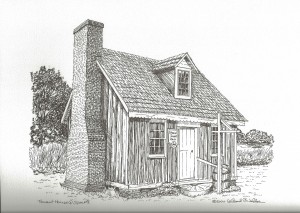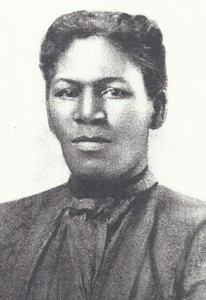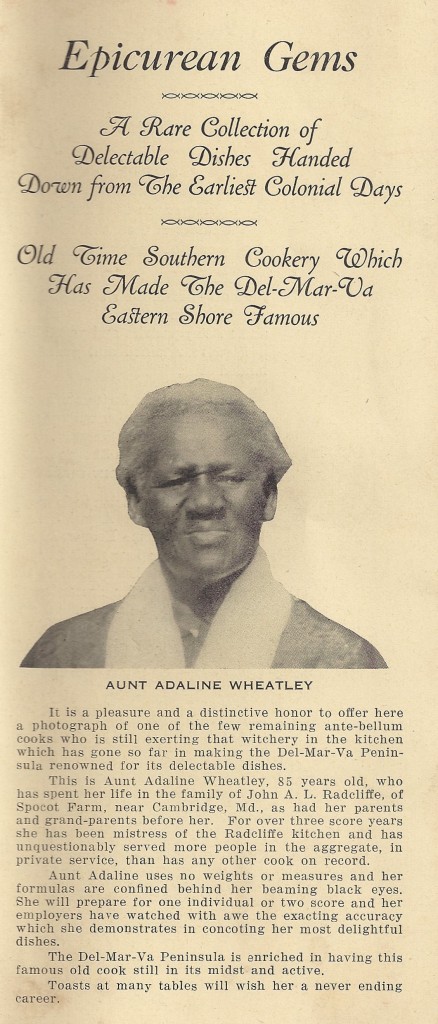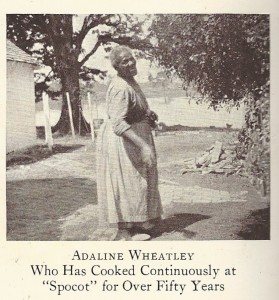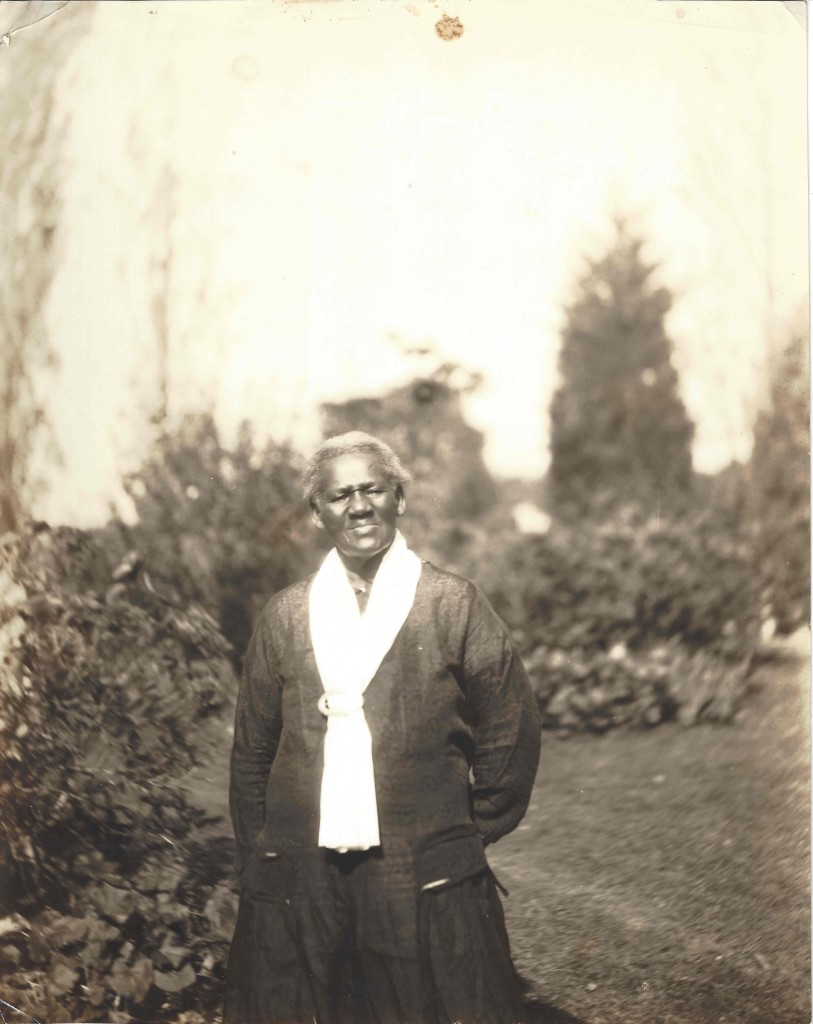Adaline Wheatley Cottage
The Spocott Windmill Foundation has recently renamed the Miller’s Cottage as the Adaline Wheatley Cottage. The building was in fact used by Adaline and her family at Spocott for almost 100 years, and while she has always been recognized in the current building, it seemed more appropriate to actually give the building the name of its well-known and beloved owner. The building predated her and was built between 1775 and 1825 as the original tenant house for Spocott, probably by the LeCompte family which inhabited Spocott at the time. From 1845 until the start of the Civil War, John Anthony LeCompte Radcliffe’s brothers, William and Nehemiah, lived in the house while the 3 brothers built schooners. After the Civil War, Adaline and Columbus Wheatley raised their large family in the house, and it was used by members of her family well into the 1950’s. The house was originally constructed close to the main house and moved out to the end of Spocott lane during Adaline’s life. After her death in 1929, the house was moved back to the interior of the property and was moved to the windmill complex in 1975.
Adaline Wheatley was a resident of the Spocott community for all of her 86 years, serving as cook, nurse, and house manager in addition to helping raise the children of John A. L. and Sophie Radcliffe. In every remembrance written of time spent at Spocott, she clearly was the star attraction, touching everyone she met. She married Columbus Wheatley, a former slave on the Spocott property, after he returned from fighting in the Civil War, and she and Columbus raised their 7 children at Spocott. Each of the children was given a job on the property until they were established enough to find work elsewhere. Her granddaughter was still living at Spocott into the 1950’s.
Little is known of Adaline’s early life, but she always claimed she had been born on the Spocott property as had her parents and grandparents. There is no evidence that she was ever a slave at Spocott although there were slaves on the property at the time of her birth, and one would assume her parents and grandparents had been. She was at Spocott when John Anthony LeCompte Radcliffe assumed ownership of the property in 1847. She was clearly a favorite of John and soon became revered for both her cooking ability, common sense, and sharp wit.
Columbus and his brother Augustus had assisted John AL Radcliffe with his shipbuilding until 1860. Both, after being officially granted freedom during the Civil War, briefly tried farming. Unsuccessful, Columbus then enlisted on Dec. 25, 1863 in the 19th Regiment of the United States Colored Infantry at Camp Stanton in Benedict, MD. On April 19, 1864 Columbus transferred from the U.S. Army to the U.S. Navy with the rank of Landsman. From that date until June 15, 1866 he served on the USS Allegany in Baltimore, MD, the USS Princeton in Philadelphia, PA, and the USS New Hampshire in Port Royal, SC.
In 1866 he returned to work with John Anthony LeCompte Radcliffe at Spocott and soon after married Adaline. The two settled into a house on the Spocott property, where they would both spend their entire lives, raising their 7 children. Columbus worked side-by-side with John on his many construction projects and played a major role in the farming operation. He was always thought of as a jack-of-all-trades. John clearly trusted Columbus as much as anyone on the property at that time. Adaline continued as the cook and over her lifetime assumed more and more roles, including nurse and eventually house manager.
George L. Radcliffe clearly remembered Adaline’s role as chief nurse at Spocott. As she did in the kitchen, she always wielded her magic, especially with the children. John and Sophie had both been previously married and had 19 children between the two of them. Spocott was full of children and grandchildren at any point in time. At that time with so many children always around, there always seemed to be one child in quarantine. Adaline was always there to lend her touch. Although with no formal nursing training, she possessed enough common sense and basic smarts to more than suffice. Sophie was in poor health for her last few years, and Adaline became her full time caregiver. What amazed George was that with all these additional responsibilities, she never once missed preparing a meal in all her years.
Adaline and Columbus came to be considered family and were beloved by all at Spocott. They were referred to as “Uncle Columbus” and “Aunt Adaline” by all at Spocott and the surrounding community; these titles clearly were terms of endearment. John passed away after the turn of the century, and Columbus passed away in 1910, but Sophie and Adaline lived out their remaining years together at Spocott. Adaline was extremely intelligent, and all knew and sought out her wisdom. Every visitor would spend considerable time in the kitchen, and it was never known whether her cooking or her advice were the bigger draw.
Her cooking was known far and wide. She was used as the cover subject on a brochure on Eastern Shore cooking in the 1920’s, referring to her cookery as “witchery in the kitchen”. She was always being sought after for her recipes, but it turns out that she had none. What she did possess was an instinctive ability to create an amazing dish, never once referring to a recipe or ever use a measuring cup or spoon.
She was always found in the outdoor kitchen at Spocott, between the house and the water. Outdoor kitchens were commonplace at this time, primarily for reasons of fire safety. Her coal-fired stove was always red hot, even on the hottest of summer days.
Two points need to be made about cooking at Spocott at that time. Spocott was the home for a veritable community. In addition to John and Sophie’s large families, there were always cousins and their children and frequent visitors at the house. John had a policy of opening his large house to any visitor anytime. Even at night the house was overflowing with overnight guests. Sen. George L. Radcliffe recounted one evening when the Governor of Maryland slept on the floor because there was no bed space available. So Adaline was always cooking for a crowd, often preparing a second dinner when another wave of guests arrived. This may have been a large part of why she used no recipes. A planned dinner for 12 would soon turn into a feast for 22.
Those who watched her cook stood in amazement as she threw ingredients together in a flash, frequently having to increase quantities as the guest list continued to increase, with the result always being an amazing meal. Her reputation spread far and wide. Adaline also had to be the impromptu cook with fish, crabs, oysters, and game suddenly appearing in the kitchen awaiting her magic. She simply smiled and added this to the multiple tasks already ongoing.
Sen. Radcliffe would say that a visitor coming to Spocott would first greet Sophie and then go out to the kitchen to visit Adaline. There was always something brewing: a meal in progress, a pie just out of the oven, or freshly made biscuits. Visitors and family would sit, eat, and converse with Adaline. They would get more than just the latest news or story, although these were welcome; there would be a morsel or two of advice and wisdom intertwined. Sen. Radcliffe remembers one instance when the Maryland Governor sat out on the kitchen for more than a half hour, sampling her amazing cooking and receiving what he deemed “great” advice as he took notes. What a tragedy that those amazing recipes and that marvelous wisdom were never recorded, but they profoundly influenced those who knew her.
At the end of her life, she was honored by a number of groups. Swepson Earle in 1923 included her in his treatise The Chesapeake Bay Country. But it was her caring and wisdom that endeared her to the family, granting her a place of tremendous respect in the family.
Sophie and John added 3 children of their own in the 1870’s with George, the youngest, born in 1877. Adaline helped raise the children, and George in later years often spoke of her as a second mother. Although George was clearly close to his mother, the presence and attention of Adaline made his early years very pleasant ones. Adaline was to play a major role in raising a future United States Senator.
Sophie’s health failed during the last 5 or so years of her life, and Adaline became her constant companion and caregiver. Both in their 80’s, they were inseparable. Adaline, even in her advanced years, still continued to cook every meal and manage the house while continuing her round-the-clock nursing care. It was an ironic friendship considering their beginnings. The two spent the better part of their lives together and became inseparable at the end. Sophie passed away Jan. 17, 1927, and Adaline continued to live at Spocott until her death on June 15, 1929.
The lives and friendship of the Radcliffe and Wheatley families mirrored the changes in the country during the period in which they lived. Born in a time when slavery was still the norm in this area of the country, they evolved with the dissolution of slavery. Sophie came from a family that had accepted slavery although their slaves had been treated well. Columbus was born a slave, and Adaline, at the very least, grew up surrounded by slavery. They all came from a time when blacks were considered inferior beings, and that mindset for both races could not have disappeared quickly. Freedom brings some choices where one had had none before, but there was still a chasm caused by years of a certain mindset and lack of education. Adaline’s education was one shaped by her experiences. Her children were stunted in their education by the limited education that blacks received in this area. John Anthony LeCompte Radcliffe, while in the Maryland Legislature, actually fought for increased funding for the education of blacks. We do know that John and Sophie plus their children did provide educational experiences for Adaline’s children, but even more important her children were given their first work experience and excellent references. Freeing slaves was not always the panacea that it seemed; freedom was a long way from equality. There were still limited work experiences available for blacks and very limited capital for starting one’s own business. For years John and then Sophie provided the work experiences although as Spocott fell on hard times after the turn of the Century, this became more difficult. Adaline’s descendants continued to work at Spocott, some until the early 1960’s.
Adaline always accepted her role as a servant and seemed totally content with her situation. A woman with her obvious intelligence and skill could have gone far in the 21st Century. However, Adaline affected so many people, including the army of children she impacted; it’s hard to imagine anyone being any more significant than she was. What made Spocott so amazing and unusual at that time is that the family had 2 matriarchs. Young George went on to become a national figure and U.S. Senator and always gave a lot of credit to his having 2 strong female influences in his early years. When Adaline finally passed in 1929, her funeral service was held at a small black church in the area. She was buried there beside her beloved husband Columbus. George L. Radcliffe, one of the many children she helped raise, gave the eulogy at her service. Several years later George paid for a tombstone to go over her grave in Zoar Church Cemetery near Morris Neck. The stone read “For 65 years devoted employee and friend of Mrs. John A. L. Radcliffe, whose sons Thomas B., J. Sewell, and George L. erect this.” His affection for her was obvious to all. George was to go on and become a United States Senator, but he never forgot his roots.

